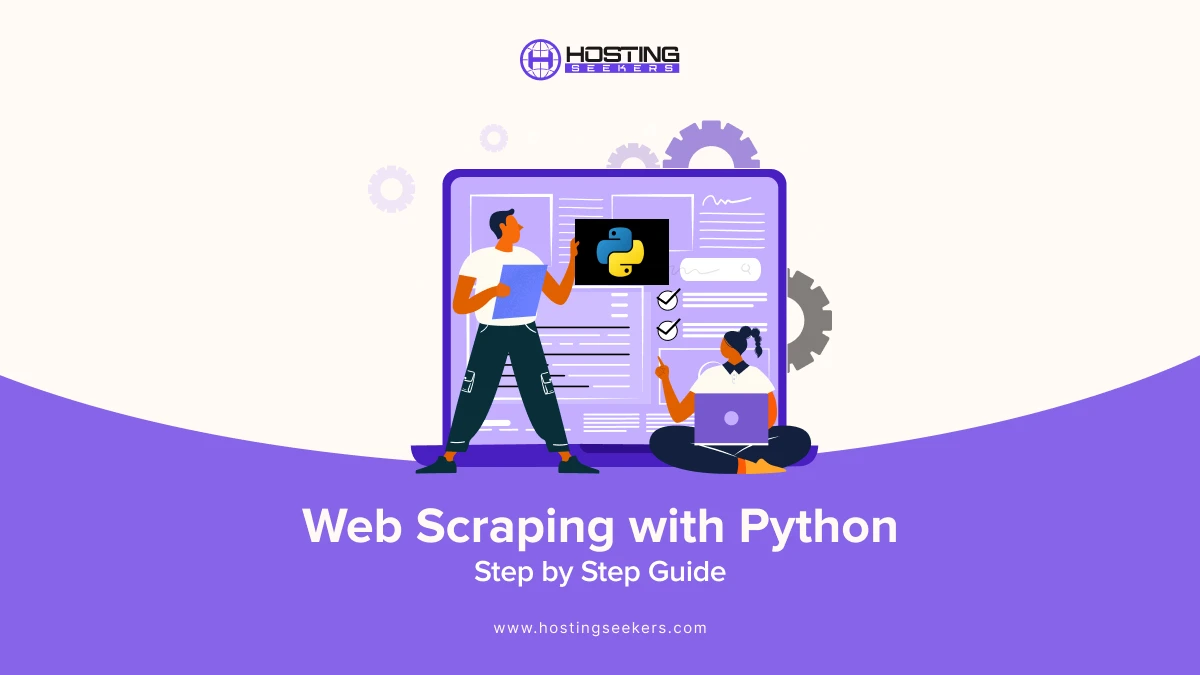
Web scraping is the strategic method to extract data from the websites. This process automates the fetching of data and information into structed data that business can use for a multitude of strategic operations.
Python is among the recommended for web data scraping. It is specially useful for researchers, data scientists, marketers and business analysts, and its the most valuable tool you must add to your skill set. Let’s first understand what web scraping is.
What is Web Scraping?
Web scraping is a method to extract a large amount of data from various websites. The term “Scraping” refers to obtaining data from other webpages and saving it into local files.
For instance: Suppose you are working on a project named “Phone comparing website” where you need the price of mobile phones, ratings, and model names to make comparisons between the different mobile phones.
If you gather these details by analyzing and monitoring different websites, it will take so much time. Therefore, web scraping plays a vital role whereby writing just a few lines of code you can get the desired results.
Is Web Scraping Legal?
While web scraping is not illegal, how it is performed, and the data’s subsequent usage can raise legal and ethical concerns. Actions like scraping content which is copyrighted and personal information without consent or engaging in activities that disrupt the normal functioning of a website may be considered illegal.
Also, the legality of web scraping mostly depends on the specific circumstances and jurisdiction. In US, for instance, web scraping can be considered legal as long as it does not defy upon the computer fraud and Abuse ACT ( CFAA), the Digital Millennium Copyright Act (DMCA) or violate any terms of service agreements.
Why Use Python for Web Scraping?
There are other famous programming languages, but why select python over other programming languages for web scraping? Here are a few reasons why Python is used for web scraping.
1. Ease of Use and Readability
Python’s syntax is simple and intuitive, making it easy to write and maintain scrap scripts. Its readability allows developers to quickly understand and modify code.
2. Rich Ecosystem of Libraries
Python has a vast collection of libraries specifically designed for web scraping, such as:
- Beautiful Soup: For parsing HTML and XML documents.
- Scrapy: A powerful framework for building web crawlers.
- Requests: For making HTTP requests.
- Selenium: For automating browser interactions, especially useful for dynamic websites.
- Pandas: For data manipulation and analysis after scraping.
3. Flexibility
Python can handle both simple and complex scraping tasks, from extracting data from static pages to interacting with JavaScript-heavy websites. It supports multiple data formats (HTML, JSON, XML) and can integrate with databases and APIs.
4. Community Support
Python has a large and active community, providing extensive documentation, tutorials, and forums for troubleshooting. This makes it easier to find solutions to common scraping challenges.
5. Cross-Platform Compatibility
Python runs on multiple platforms (Windows, macOS and Linux), making it accessible for developers regardless of their operating system.
Python is a popular language for data analysis and machine learning. Scraped data can easily be processed and analyzed using libraries like NumPy, Pandas, and Matplotlib.
6. Scalability
With frameworks like Scrapy, Python can handle large-scale scraping projects efficiently.It can be integrated with distributed systems and cloud services for even greater scalability.
7. Legal and Ethical Considerations
Python’s libraries often include features to respect robots.txt files and handle rate limiting, helping developers scrape responsibly.
How does Web Scraping Work?
Web scrapping includes three steps:
1. Data Collection: Data is gathered from webpages mostly with a web crawler.
2. Data transformation and parsing: This next step includes transforming the collected dataset into a format that can be utilized for further analysis like JSON or Spreadsheet file.
3. Data Storage: The last stage of web scraping includes storing the transformed data in XML, JSON, or CSV file.
Let’s Start with Basics of Web Scraping
The basics of web scraping
The web scraping includes two parts: a web crawler and a web scraper. Let’s explore the two components of web scraping.
The Crawler
A web crawler is mostly named spider. It’s an AI technology that browsers the web and searches the content by the mentioned links. It searches for the relevant data asked by the programmer.
The Scrapper
A web scraper is a dedicated tool that is developed and designed to extract data from various websites effectively and quickly. Web scrappers can vary widely in design and challenges, depending on the projects.
Step by Step Guide for Web Scraping with Python
Web scraping is the process of extracting data from websites. Python is a popular language for web scraping due to its simplicity and the availability of powerful libraries like BeautifulSoup, requests, and Scrapy. Below is a step-by-step guide to web scraping with Python:
Step 1: Understand the Legal and Ethical Considerations
- Check the website’s robots.txt file: This file (e.g., https://example.com/robots.txt) specifies which parts of the site can be scraped.
- Respect the website’s terms of service: Some websites prohibit scraping.
- Avoid overloading the server: Use delays between requests to avoid causing downtime.
Step 2: Install Required Libraries
You’ll need the following Python libraries:
- requests: To send HTTP requests and fetch the webpage content.
- BeautifulSoup (from bs4): To parse HTML and extract data.
- lxml or html.parser: As a backend parser for BeautifulSoup.
- Optional: pandas for data manipulation and storage.
Install them using pip:
pip install requests beautifulsoup4 lxml pandas
Step 3: Inspect the Website
- Open the website in your browser (e.g., Chrome).
- Right-click on the page and select Inspect to open the Developer Tools.
- Identify the HTML elements that contain the data you want to scrape.
Step 4: Fetch the Webpage
Use the requests library to send an HTTP GET request and fetch the webpage content.
import requests
url = “https://example.com”
response = requests.get(url)
# Check if the request was successful
if response.status_code == 200:
html_content = response.text
else:
print(f”Failed to retrieve the webpage. Status code: {response.status_code}”)
Step 5: Parse the HTML Content
Use BeautifulSoup to parse the HTML and extract data.
from bs4 import BeautifulSoup
# Parse the HTML content
soup = BeautifulSoup(html_content, “lxml”)
# Example: Extract the title of the webpage
title = soup.title.text
print(f”Title: {title}”)
Step 6: Extract Data
Use BeautifulSoup methods to find and extract specific elements.
Example: Extract all links
links = soup.find_all(“a”)
for link in links:
print(link.get(“href”))
Example: Extract text from specific elements
# Find all elements with a specific class
headings = soup.find_all(“h1″, class_=”heading-class”)
for heading in headings:
print(heading.text)
Example: Extract data from a table
table = soup.find(“table”)
rows = table.find_all(“tr”)
for row in rows:
cells = row.find_all(“td”)
for cell in cells:
print(cell.text)
Step 7: Handle Pagination
If the data is spread across multiple pages, you’ll need to handle pagination.
base_url = “https://example.com/page=”
for page in range(1, 6): # Scrape first 5 pages
url = base_url + str(page)
response = requests.get(url)
soup = BeautifulSoup(response.text, “lxml”)
# Extract data from each page
Step 8: Store the Data
You can store the scraped data in a CSV file, database, or any other format.
Example: Save data to a CSV file using pandas
import pandas as pd
data = {
“Title”: [“Title 1”, “Title 2”],
“Link”: [“https://example.com/1”, “https://example.com/2”]
}
df = pd.DataFrame(data)
df.to_csv(“scraped_data.csv”, index=False)
Step 9: Handle Dynamic Content (Optional)
Some websites load content dynamically using JavaScript. In such cases, you’ll need a tool like Selenium or Playwright to render the page.
Example: Using Selenium
pip install selenium
from selenium import webdriver
driver = webdriver.Chrome() # Ensure you have the ChromeDriver installed
driver.get(“https://example.com”)
# Extract data after the page has loaded
content = driver.page_source
soup = BeautifulSoup(content, “lxml”)
# Proceed with scraping
driver.quit()
Step 10: Add Delays and Randomization
To avoid being blocked, add delays between requests and randomize user-agent headers.
import time
import random
headers = {
“User-Agent”: “Mozilla/5.0 (Windows NT 10.0; Win64; x64) AppleWebKit/537.36 (KHTML, like Gecko) Chrome/91.0.4472.124 Safari/537.36”
}
for page in range(1, 6):
url = base_url + str(page)
response = requests.get(url, headers=headers)
time.sleep(random.uniform(1, 3)) # Random delay between 1 and 3 seconds
Step 11: Handle Errors and Exceptions
Add error handling to manage issues like network errors or missing elements.
try:
response = requests.get(url, headers=headers)
response.raise_for_status() # Raise an error for bad status codes
except requests.exceptions.RequestException as e:
print(f”Error: {e}”)
Step 12: Advanced Scraping with Scrapy (Optional)
For large-scale scraping, consider using Scrapy, a powerful web scraping framework.
pip install scrapy
Create a Scrapy project:
scrapy startproject myproject
Define a spider to scrape data:
import scrapy
class MySpider(scrapy.Spider):
name = “myspider”
start_urls = [“https://example.com”]
def parse(self, response):
for item in response.css(“div.item”):
yield {
“title”: item.css(“h2::text”).get(),
“link”: item.css(“a::attr(href)”).get(),
}
Run the spider:
scrapy crawl myspider -o output.json
Summing Up
And that wraps up our step-by-step guide to Python web scraping! Now that you’ve mastered the basics of extracting data from websites, the web is your playground.Whether you’re tracking competitor prices, monitoring social media mentions, or gathering insights for research, web scraping opens up limitless possibilities for both business and personal projects.
Frequently Asked Questions
Q 1. Which tools should I use to safely scrape the web?
Ans. To safely scrape the web, follow robots.txt rules, use rate limiting to avoid overloading servers, rotate user agents and proxies to prevent IP bans, and ensure compliance with legal and ethical guidelines.
Q 2. How can AI be used in web scraping?
Ans. AI improves web scraping through intelligent parsing, CAPTCHA solving, NLP-based data extraction, automated data cleaning, and OCR for text extraction from images.
Q 3. How to save scraped data as a CSV file using Scrapy?
Ans. In Scrapy, save scraped data as a CSV by running scrapy crawl my_spider -o output.csv, or write data to a file using Python’s CSV module inside a Scrapy pipeline.
Q 4. How do I scrape data through Python?
Ans. Use Python web scraping libraries like requests and BeautifulSoup for static pages, and Selenium or Playwright for JavaScript-heavy sites, extracting data by targeting specific HTML elements.
Q 5. Is web scraping illegal?
Ans. Web scraping is not illegal by default, but it can become illegal if it violates terms of service, data privacy laws (like GDPR), or involves bypassing authentication measures. Always check a website’s policies.
Q 6. Is web scraping faster than API?
Ans. APIs are faster than web scraping because they provide structured data directly, while web scraping requires downloading, parsing, and handling dynamic content, making it slower and more resource intensive.
Q 7. How to get data from a URL in Python?
Ans. Use Python’s requests library to send an HTTP request to a URL and retrieve its content, which can then be processed using string operations or parsing techniques.
Q 8. How to extract data in Python?
Ans. Data extraction in Python depends on the source, using HTML parsing for web pages, JSON parsing for APIs, SQL for databases, OCR for images, and specialized libraries for PDFs and text files.
Q 9. Is web scraping a bot?
Ans. Yes, web scraping is a type of bot that automates the process of accessing and extracting data from websites, often mimicking human browsing behavior to collect information efficiently.
